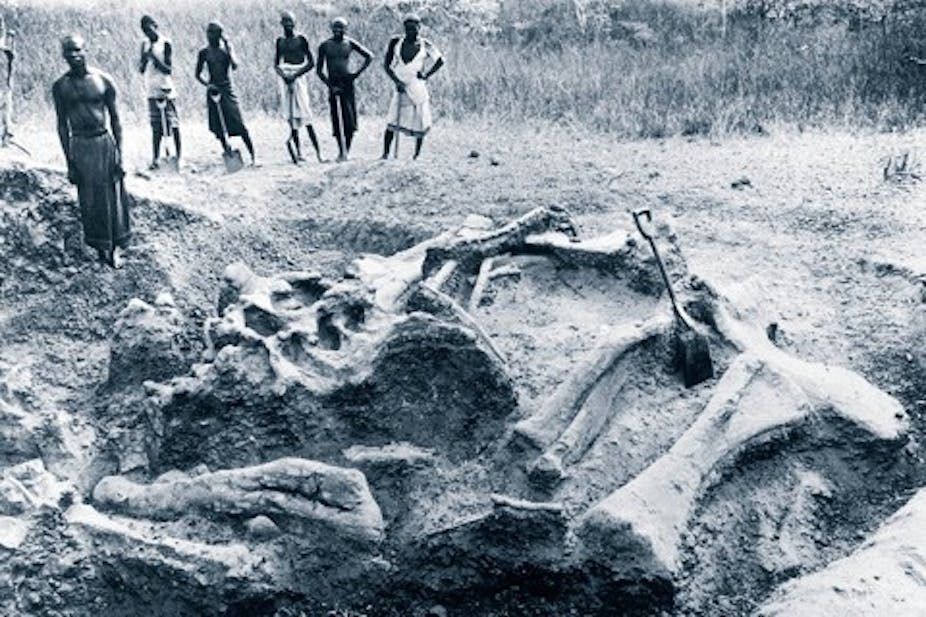There are few things more exciting for a professional palaeontologist than discovering fossil remains. In early 2017 I found a beautifully preserved skeleton sticking out of the ground in South Africa’s Karoo region. It was the vertebral column of a big herbivorous animal called pareiasaur.
The individual vertebral arches were accompanied by the animal’s two hip blades. Fragments of its forelimbs and some parts of its cranium were also visible. All this suggested that I’d found a skeleton nearly 2 meters long, the rest of it hidden below the ground. These 275 million years old fossils had no deformities and were easy to identify. I realised that even someone with no training in palaeontology would have easily find such eroding bones and recognised them as some giant creature’s remains.
This got me thinking about Africa’s earliest fossil seekers, whose identities are largely unknown. Who were they, and how did their discoveries influence our thinking about evolution? How many of their ideas were dismissed or written out of history after the arrival of colonialism and western fossil hunters on the continent?
It’s important to honour these people and their fossil finds, which are examples of both cultural and palaeontological heritage.
Historical fossil hunting in Africa
For many, the history of fossil bone discovery in Africa can’t be separated from famous European-led expeditions. Many of these happened during the 19th and 20th centuries and generated breathless headlines around the world.
There was the German expedition at Tendaguru (Tanzania), which yielded the extraordinary skeletons of some of the biggest dinosaurs ever found. American and European palaeontologists also mounted several trips to the Fayum depression in Egypt because it was home to mammals of all sorts and sizes some 35 million years ago.

These expeditions captured the public’s imagination. But the archaeological record reveals that fossils were discovered and collected well before such trips, by amateurs who used them in, for instance, religious rituals.
In her book about fossil discoveries in classical Antiquity, “The First Fossil Hunters”, Adrienne Mayor mentions that gigantic bones were found in Morocco as early as 300 to 400 B.C. She suspects they were fossilised elephants.
One of the most famous ancient fossil discoveries in Africa involved a giant tooth. Christian theologian and philosopher Saint Augustin, the bishop of what is today Algeria, found it near Utica (Tunisia) in the fourth century A.D. It proved to be a fossilised elephant molar.
Saint Augustin’s discovery isn’t the oldest example of fossil collection in Africa, though. That title goes to the ancient Egyptians who collected and gathered millions of years old mammalian fossil bones and packed them in linen, likely as a form of worship to Set. These fossil collectors lived 3000 years ago. There’s also evidence of fossilised shark teeth that were collected and pierced to be worn as pendants in ancient Egypt, some 6500 years ago.
The search for the first fossil collectors
It’s possible that fossils were recognised in Africa even earlier than this. In Congo, a site dating back 21 000 years has yielded the tooth of a fossil elephant that went extinct millions of years earlier. This suggests that someone stumbled upon this large fossil tooth and brought it back home, perhaps as a curio.
In addition, an undated Khoisan rock art site in Lesotho appears to represent dinosaur footprints. Fossil tracks dating back more than 200 million years ago are not uncommon in this region, and are often well exposed – lying close to the surface of the earth – so it makes sense that ancient residents would have seen and documented them. The Khoisan could well have been the first people to find fossils in Southern Africa.
Though this hypothesis is still hotly debated, these drawings are accompanied by cave paintings which suggest the Khoisan interpreted these footprints as belonging to a race of giant, flightless birds. Today, most scientists consider birds to be dinosaurs’ closest living relatives. This would imply that Khoisans ancestors had a remarkable sense of scientific reconstruction, even though no framework for evolution had yet been described.
Before Darwin
The Khoisan weren’t the only people in Africa thinking way ahead of the Darwinian curve. A number of Muslim scholars from the Middle East and North Africa made very explicit, farsighted statements centuries before Darwin.
For example, a Tunisian scholar named Ibn Khaldun, stated as early as 1377 that “the higher stage of man is reached from the world of the monkeys, in which both sagacity and perception are found.” He was probably inspired by his predecessor, the Persian Ibn Miskawayh (932-1030), who stated in the Brethren of Purity that “Animalilty […] finally reaches the frontier of humanity with the Ape which is just a degree below Man in the scale of evolution”.
It’s very likely that Darwin didn’t know about these ancient discoveries and medieval authors since they are not mentioned in any of his biographies or works. But the very fact that they exist illustrates Africa’s formidable potential to influence and develop palaeontological research.
The challenge now is to build upon this heritage and raise awareness about these long-forgotten discoveries and theorists. This is an important way to motivate a new generation of African fossil researchers.

